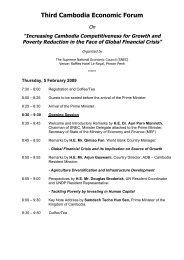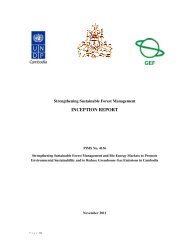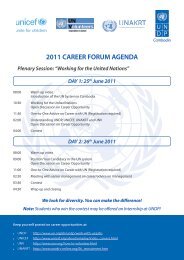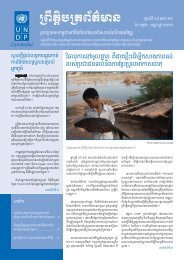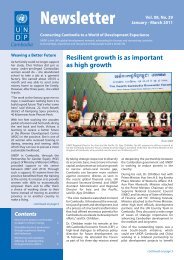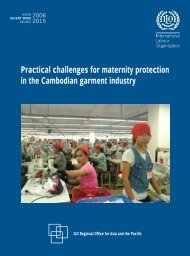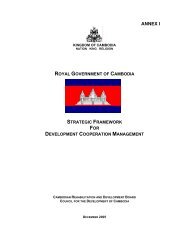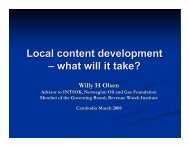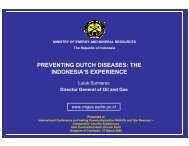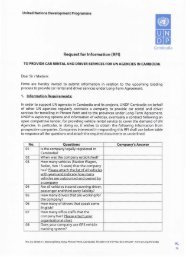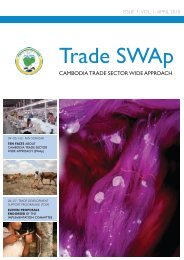UN Analysis Final.pdf - United Nations in Cambodia
UN Analysis Final.pdf - United Nations in Cambodia
UN Analysis Final.pdf - United Nations in Cambodia
Create successful ePaper yourself
Turn your PDF publications into a flip-book with our unique Google optimized e-Paper software.
7.2.1 YOUTH VULNERABILITY AND THE CHALLENGES OF POVERTY<br />
Poverty is a multi-dimensional issue that engenders risk and vulnerability, not least among young people<br />
from poor households. In a study on Manag<strong>in</strong>g Risk and Vulnerability <strong>in</strong> <strong>Cambodia</strong>, the World Bank (2006)<br />
found a complex set of factors lead<strong>in</strong>g to this situation. The majority of young people aged 15-24 live <strong>in</strong><br />
rural areas. They constitute 26 per cent of the country’s total population, of which about 35 per cent live<br />
below the poverty l<strong>in</strong>e (MoP 2006). Because their livelihoods are mostly dependent on ra<strong>in</strong>-fed agriculture,<br />
these youths often experience food <strong>in</strong>security. Moreover, they lack vocational skills and the opportunity<br />
to access vocational tra<strong>in</strong><strong>in</strong>g. Hence, the majority are unemployed or underemployed for most of the year.<br />
With little access to land, these youths receive limited education and economic opportunities (World Bank<br />
2006; Fitzgerald and So 2007). Consequently, they decide to move to cities <strong>in</strong> the hope of employment<br />
and a more excit<strong>in</strong>g life, caus<strong>in</strong>g a massive urban drift.<br />
Social exclusion and poverty both contribute to vulnerability <strong>in</strong> youth. Young people are those most affected<br />
by family shocks, such as death or the chronic illness of the household head, the loss of the family’s assets<br />
or f<strong>in</strong>ancial debt. The biggest challenge fac<strong>in</strong>g young people at risk is the lack of opportunity for paid or<br />
productive employment. Unemployment is not evenly spread, and the situation of vulnerable groups<br />
varies accord<strong>in</strong>g to different conditions and circumstances (Brewer, 2004). Unemployed young people<br />
are affected by a lot of serious social issues, such as gett<strong>in</strong>g drawn <strong>in</strong>to gangs, alcohol consumption and<br />
drug abuse. However, it was found that unemployment among youth falls when education is improved.<br />
Hence, it is very important to take <strong>in</strong>to account <strong>in</strong>creas<strong>in</strong>g opportunities at all levels of the educational<br />
ladder to reduce youth vulnerability. Young people less cared for by their families, those grow<strong>in</strong>g up <strong>in</strong> poor<br />
households, those who are early school leavers or do not attend school, and some of those from ethnic<br />
communities <strong>in</strong> remote areas, have been found to be disproportionately at risk of social exclusion. There<br />
are also particular times when young people are most vulnerable, such as when they leave home, their<br />
families or school (Brewer, 2004). Figure 7-1 summarizes the implications of poverty on youth well be<strong>in</strong>g.<br />
FIGURE 7-1. KEY DRIVERS OF POVERTY AND THEIR IMPLICATIONS FOR YOUTH<br />
Key drivers of chronic poverty<br />
Severe and/or repeated shocks<br />
Ill-health and <strong>in</strong>jury<br />
Environmental shocks and natural disasters<br />
Market and economic collapse<br />
Violence and conflict<br />
Breakdown of law and order<br />
PLUS<br />
Few private or collective assets to fall back on<br />
(Limited physical, f<strong>in</strong>ancial, social or human<br />
capital, highly susceptible to shocks)<br />
PLUS<br />
Ineffective <strong>in</strong>stitutional support<br />
(e.g. lack of effective social protection, public <strong>in</strong>formation, basic<br />
services, conflict prevention and resolution)<br />
PLUS<br />
Poverty occurr<strong>in</strong>g at certa<strong>in</strong> po<strong>in</strong>ts <strong>in</strong> an <strong>in</strong>dividual or household’s<br />
life (e.g. childhood, old age, youth and young households).<br />
Examples of implications for youth<br />
Young people are often <strong>in</strong> the early stages of physical<br />
and f<strong>in</strong>ancial asset accumulation, and as such, they may<br />
f<strong>in</strong>d it particularly difficult to weather and bounce back from<br />
a shock.<br />
Young couples may deplete their assets or reduce their<br />
own consumption to ensure that their young children are<br />
healthy and educated.<br />
Even <strong>in</strong> labour markets with social <strong>in</strong>surance mechanisms<br />
<strong>in</strong> operation, young people generally have not built up the<br />
time or contributions to benefit.<br />
When young people are is forced to leave school before<br />
achiev<strong>in</strong>g a secondary, tertiary or vocational qualification,<br />
there are reduced returns to, or a complete loss of the<br />
significant long-term <strong>in</strong>vestment <strong>in</strong> education, time and<br />
resources made by the young people and their families. It<br />
becomes more difficult to f<strong>in</strong>d productive work and rebuild<br />
assets.<br />
LIKELY TO TRAP PEOPLE IN POVERTY<br />
Source: Adopted from Moore (2006)<br />
82 Situation <strong>Analysis</strong> of Youth <strong>in</strong> <strong>Cambodia</strong>




